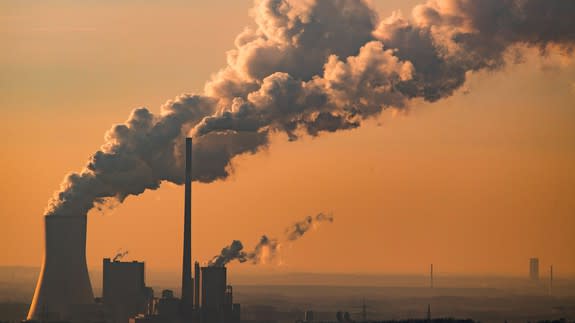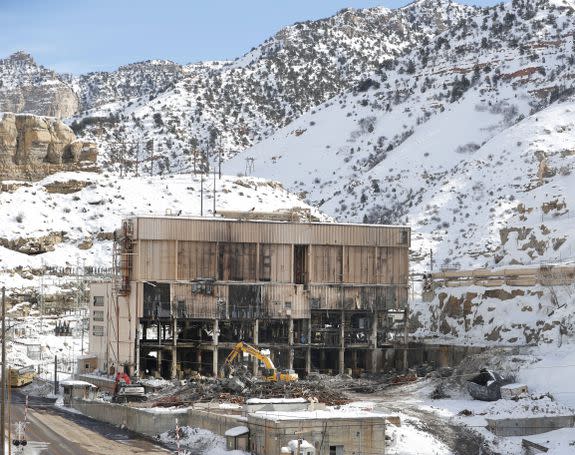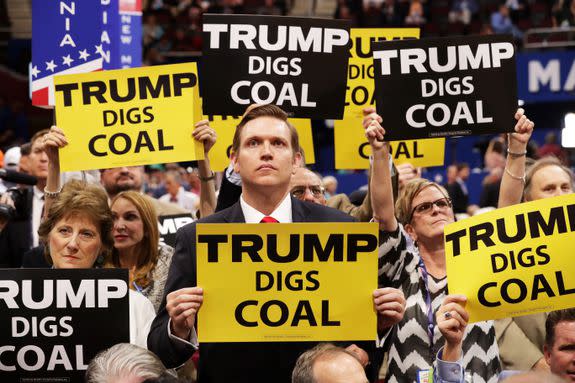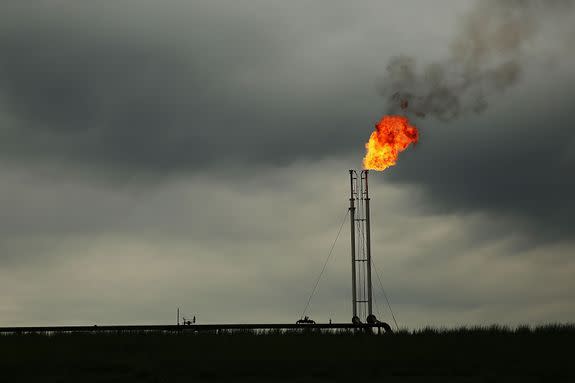Coal-fired electricity is at its lowest since officials started keeping track

President Donald Trump has vowed to restore the long-struggling U.S. coal sector. The only problem? America's power plants have already moved on.
Natural gas and renewable energy together produced half of U.S. electricity supplies in 2016, while coal made up just 30 percent — its smallest share since officials started keeping track 70 years ago.
SEE ALSO: No, U.S. climate scientists didn't trick the world into adopting the Paris deal
Thanks to that shift, total U.S. greenhouse gas emissions plunged to a 25-year low last year, putting the nation on track to meet emissions reductions targets set by former President Barack Obama.
That's all according to the 2017 Sustainable Energy in America Factbook published Wednesday by Bloomberg New Energy Finance (BNEF) and the Business Council for Sustainable Energy (BCSE). The factbook compiles energy and climate data from U.S. government agencies and industry groups.
"We're building natural gas plants, we're building renewables, and we're retiring coal plants," said Colleen Regan, head of North America power and environmental markets at BNEF.

Image: Ethan Miller/Getty Images
"These aren't one-off records or years," she added. "It's a larger structural change in the U.S. economy."
A 'historic shift'
The report helps illustrate the large-scale transformation happening across the U.S. electric grid.
Cheap and abundant natural gas is edging out higher-cost coal, which is prompting utility companies to retire coal plants earlier than planned. Wind and solar power costs are plummeting thanks to improving technologies, while energy efficiency measures are reducing overall energy demand. All these limit the need for new coal-fired power plants.
"It makes a lot of sense that utilities plan longer-term investments at the lowest-cost options that they have available, and [natural gas and renewables] are the two evident ones in the U.S.," said Tim Boersma, a senior research scholar at Columbia University's Center on Global Energy Policy.

Image: George Frey/Getty Images
In 2016, natural gas became the No. 1 source of U.S. electricity for the first time. It made up 34 percent of the nation's power mix, up from just 22 percent in 2007.
Renewable energy and hydropower together supplied 15 percent of U.S. power in 2016, up from 9 percent over the same time frame. That percentage will continue to grow as new projects come online: Last year, the U.S. added a whopping 12,500 megawatts of solar power and 8,500 megawatts of wind power.
Coal, by contrast, moved in the opposite direction.
Along with natural gas competition, the sheer age of the facilities and tougher pollution regulations pushed utilities to shutter 7,000 megawatts of coal-fired capacity last year, on top of the record 15,000 megawatts retired in 2015.

Image: U.S. Energy information administration
That's helped reduce coal's share of U.S. electricity to 30 percent, down from 48 percent in 2008.
"The power sector is in the midst of a pretty historic shift away from coal," said Rachel Cleetus, a lead economist and climate policy manager for Union of Concerned Scientists, an advocacy group.
What's next?
Energy analysts say this shift will continue in years to come, even if Trump acts on his promises to gut key Obama-era climate policies, such as the Clean Power Plan.
Trump, who has previously called climate change a "hoax," falsely claimed in December that "nobody really knows" what's happening to the planet. The president has also tapped well-known climate deniers and fossil fuel executives to lead key cabinet posts.

Image: Chip Somodevilla/Getty Images
According to the 2017 Factbook, the U.S. is already three-quarters of the way to meeting the goals of the imperiled Clean Power Plan.
That policy, which is on hold, aims to reduce power plant emissions to 32 percent from 2005 levels by 2030. So far, the sector's carbon emissions have dropped 24 percent from 2005 to 2016.
But that hardly means the U.S. is in the clear.
The recent momentum to adopt cleaner energy sources and slash emissions would likely slow if Trump scraps the Clean Power Plan and other federal climate efforts, said Boersma, the Columbia University researcher.
"The same trends we see today aren't reversed, but they are significantly slowed down," he said. "You would buy time for coal plants to live longer and see less growth in natural gas and renewables."
Coal could also recover some lost ground if natural gas prices rise, which in turn would boost U.S. emissions. Even so, coal's comeback wouldn't be nearly big enough to restore its glory days, said BNEF's Regan.
Keeping coal off the grid isn't climate experts' only concern. In coming decades, the country will also need to phase out natural gas to avoid dangerous levels of global warming, they say.

Image: spencer platt/Getty Images
Natural gas emits about half as much carbon dioxide as coal when burned — but it's also a major source of methane, which is 34 times stronger as a heat-trapping gas over a 100-year time scale.
"We're in danger of substituting one fossil fuel for another," said Cleetus of the Union of Concerned Scientists.
"While [natural gas] is certainly helping lower emissions right now, when we look ahead and see where we need to get from a climate perspective, simply switching from coal to gas is not going to be enough," she said.
